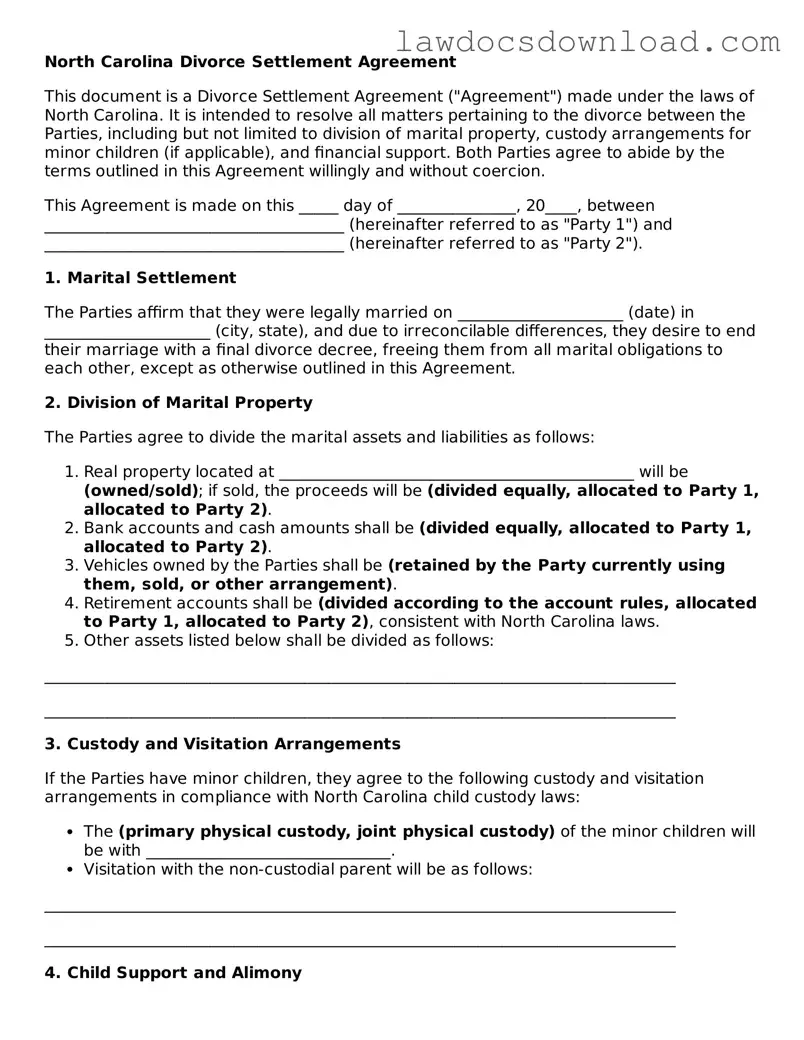North Carolina Divorce Settlement Agreement
This document is a Divorce Settlement Agreement ("Agreement") made under the laws of North Carolina. It is intended to resolve all matters pertaining to the divorce between the Parties, including but not limited to division of marital property, custody arrangements for minor children (if applicable), and financial support. Both Parties agree to abide by the terms outlined in this Agreement willingly and without coercion.
This Agreement is made on this _____ day of _______________, 20____, between ______________________________________ (hereinafter referred to as "Party 1") and ______________________________________ (hereinafter referred to as "Party 2").
1. Marital Settlement
The Parties affirm that they were legally married on _____________________ (date) in _____________________ (city, state), and due to irreconcilable differences, they desire to end their marriage with a final divorce decree, freeing them from all marital obligations to each other, except as otherwise outlined in this Agreement.
2. Division of Marital Property
The Parties agree to divide the marital assets and liabilities as follows:
- Real property located at _____________________________________________ will be (owned/sold); if sold, the proceeds will be (divided equally, allocated to Party 1, allocated to Party 2).
- Bank accounts and cash amounts shall be (divided equally, allocated to Party 1, allocated to Party 2).
- Vehicles owned by the Parties shall be (retained by the Party currently using them, sold, or other arrangement).
- Retirement accounts shall be (divided according to the account rules, allocated to Party 1, allocated to Party 2), consistent with North Carolina laws.
- Other assets listed below shall be divided as follows:
________________________________________________________________________________
________________________________________________________________________________
3. Custody and Visitation Arrangements
If the Parties have minor children, they agree to the following custody and visitation arrangements in compliance with North Carolina child custody laws:
- The (primary physical custody, joint physical custody) of the minor children will be with _______________________________.
- Visitation with the non-custodial parent will be as follows:
________________________________________________________________________________
________________________________________________________________________________
4. Child Support and Alimony
Party 1 shall pay to Party 2 the amount of _____________ per month as (child support, alimony), beginning on ____________________, 20____, and continuing (until the date, indefinitely, as per agreement details).
5. Other Provisions
The Parties may agree to other provisions not outlined above, which are as follows:
________________________________________________________________________________
________________________________________________________________________________
6. Entire Agreement
This Agreement constitutes the entire agreement between the Parties relating to their divorce and supersedes any prior understanding or agreement, oral or written. Amendments to this Agreement must be in writing and signed by both Parties.
7. Governing Law
This Agreement shall be governed by and construed in accordance with the laws of the State of North Carolina.
8. Signatures
Both Parties have read and understood this Agreement and sign it voluntarily on the date(s) below:
Party 1 Signature: ______________________________________ Date: ________________________
Party 2 Signature: ______________________________________ Date: ________________________
